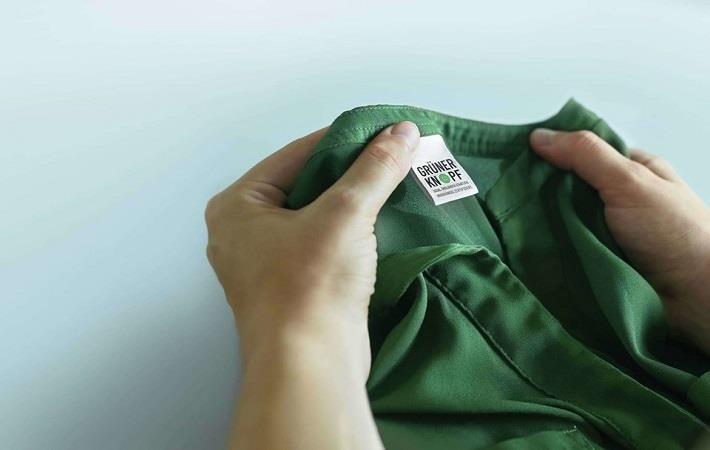
The Green Button, a German government ‘meta label’ is not yet a final method or confirmed best available technique. The meta label comprises corporate criteria that requires companies’ compliance in areas such as corporate policy, risk, and consequence management. It follows further that products earning the label also use textiles and trims that are up to a certified manufacturing standard. One of these companies is Bluesign.
The label is written in German, Grüner Knopf, and replaces the letter ‘O’ with a green garment button. The label can be sewn into the garment, or at times is only mentioned by a company in their online platforms. To earn the label, 26 social and environmental criteria must be met, and they include prohibition of child labor, a minimum wage, and other employee rights. It puts the onus on the company to measure and report their environmental bearing, and to make certain employees have the proper protective gear and clean water to drink. The circular economy philosophy of using materials that break down to lessen resource burden is employed, and as a result, air and water pollutants are measured, which is a major benefit to the label. There is marked interest from textile and fashion producers to obtain the Green Button certification, and they are entering the analysis phase to identify proper procedures and improve upon areas that fall short.
The textile manufacturing industry needs to evolve and has been hindered as a result of the absence of a world-wide label that acknowledges a certified standard of production and product inputs. This need for a standardised label extends beyond the tangible aspects of manufacturing and must also include awareness for the health and safety of factory workers.
The problem is the existence of a pervasive amount of other green certification labels that ultimately confuse the consumer, negating their importance. The Federal Minister of Economic Cooperation and Development (BMZ) of Germany, already has a list of several companies, including Bluesign, whom they can use to steer the process by using ‘The blue way’ by Bluesign, which creates a mutually agreed upon roadmap for companies to hit established, approved benchmarks. To confound matters, the meta label is only voluntary, which has its positives and negatives.
One of the negatives is that the label is limited to the country of Germany so it is highly simplified in its scope, and it doesn’t cover all methods of production, only parts of the textile process. In the modern era of social media hashtags, this is an easy target for companies looking to greenwash—meaning they choose to spend or allocate more resources to the marketing aspect of a label based on the current trend rather than embrace what the label means and incorporate it into their story—all of which only serves to undercut the meaning of these labels. This only adds to consumer confusion and is seen as another certification in a field that has several.
A positive aspect of the label being voluntary is that it isn’t backed by stringent governmental regulation. This lends weight outside of Germany and speeds up implementation since it remains in the private sector. The hope is that the voluntary structure leads to potential mandatory manufacturing standards for the supply chain.
Such a set of rules would mimic what Bluesign has already created for their assessment approach. Additionally, using gap analysis to bring products up to standards and creating a road map for companies to follow helps to position them as a supportive instrument for driving sustainability in the textile industry and potentially impacting the matrix for the Green Button.
The introductory phase of the label began in July 2019 and will run for two years. Over this period, government and private businesses will be going through an accreditation phase in hopes of speeding up the process for future companies. Bluesign is part of the Green Button accreditation phase but is only referenced in relation to the environment, and through best available techniques procures the use of sound chemistry and safe applications to minimise worker risk.
Fibre2Fashion News Desk (PC)